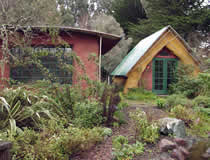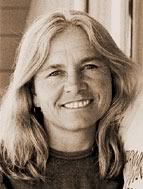PERMACULTURE: California Style
An Interview with Penny Livingston
JANUARY 2003
(Originally recorded April 18, 2000)
Part three of a three-part series
PART TWO of the Livingston Interview
PART ONE of the Livingston Interview
INTRO:
Permaculture Designer Penny Livingston concludes her ECOTECTURE interview with her own comments on the design and function of cities.
Penny Livingston is the Director of the Permaculture Institute of Northern California which offers a variety of courses including the Permaculture Design Certification Course coming in May/June 2003.
—PSW
INTERVIEW:
ECOTECTURE: This city that you were talking about, what would be the actual form it takes?
LIVINGSTON: (Laughs)
ECOTECTURE: You have already described it in a general way. . . A community with a compact structure.
LIVINGSTON: Yes. My first overlay would have been oaks, because that is the tree of this place. If you look at it from an indigenous point of view, if you have acorns and you have oak trees, you have absolutely everything from an indigenous perspective of this place. If you don't have acorns, you are just shit out of luck.
But we are Europeans, most of us, and we don't eat acorns. I would vote for putting in trees that feed people. Because that is what needs to happen right now. There is a lot of starvation in San Francisco, and, in fact, that neighborhood, the (upscale) Embarcadero where those palm trees are, you try to find some organic food somewhere within walking distance. You won't be able to. You are hard put to find any grocery store within walking distance.
| We don't have a water shortage, we have a storage shortage. |
There are already communities throughout the Bay Area where people have to get into a vehicle, burn fossil fuels, travel may blocks, if not miles out of the community to simply get food, not to mention organic food. In the landscape, when you are working with the natural world, I would think about planting things people could eat. Nut trees are really great, because they don't store pollutants in their nuts. They don't have a lot of lead. Some may, but walnuts, for example, will not store lead in their nut. We don't have a lot of leaded fuel anymore, but that is just an example. Nut trees make great food trees.
But you talk to the Mayor and the Planner and they say, "What would happen if somebody was coming along and they stumble on a nut tree and turn their ankle and they can sue the City and dada, dada, dada. . . Dada. Somebody will have to come along and pick up the nuts and leaves." That is where you have to start redefining what is important.
In the cities, we would have the greenbelts producing food and habitat, there would be clean water running through the city, bioremediated.
ECOTECTURE: Do you think enough water falls on, say, a typical city in Northern California so that it could recycle and reuse its own water without having to go to outside sources?
 |
|
|
Cricket Cottage houses guests at
the Permaculture Institute. A year-around food supply
grows in the foreground. |
LIVINGSTON: You bet. You would have to do calculations but the main issue is storage. We don't have a water shortage, we have a storage shortage. It would be challenging to store enough water for a city to use for five months out of the year. We have one of the longest dry seasons in Northern California. But, it is possible. Sure it is possible.
If you have a two thousand square foot house, and you get 24 inches of rain, which is an average rain in the San Francisco area. . . during the drought, it is a low average. . . that is two cubic feet of water falling per square foot of your roof. If you multiply that times 2,000 square feet (of roof), you have 4,000 cubic feet. Multiply that times 7.48 (gallons per cubic foot). So that would be something around 32,000 gallons of water.
ECOTECTURE: Falling on a typical roof in San Francisco?
LIVINGSTON: That is a small roof. That is a typical suburban roof.
ECOTECTURE: Do you happen to know how much water people would use in month?
LIVINGSTON: Say a family of four would use 100 gallons per day times 30 days in the month, that would be about 3,000 gallons per month. So the rainfall on the roofs alone would provide enough water for about ten months of the year.
EDITOR'S COMMENT: The calculations above do not include water that falls on the streets and other open spaces or reducing water use through conservation and recycling measures.
When you talk to urban planners . . . If we are going to get into city issues, and population, and density, the first consideration is the car. In this whole vision of the city we haven't even mentioned transportation. It is critically important that not everybody has to drive and park. I wonder how much fuel gets burned just by people driving around San Francisco trying to find a place to park. Stop at a stoplight. Drive around the block, miss the parking space, driving around for fifteen or twenty minutes just trying to find a place to park-not getting there. How many gallons of fossil fuel get burned, how much oxygen gets consumed?
The combustion engine in the city is unsustainable just from the point of view of how much oxygen it uses. Four hundred cubic feet of oxygen gets consumed for every gallon of gas that gets burned. Of that, a certain percentage does get converted back to carbon dioxide which can then get converted back to oxygen via trees and plants, but a lot of it gets converted into carbon monoxide and becomes an energy sink it doesn't get converted back to oxygen. If is wasn't for the fact that there is a breeze coming into most cities, people would be suffocating. In Mexico City, people are suffocating. They are suffering from lack of oxygen because they live in a bowl and don't have that air flow.
So, transportation. I think an electric/hydrogen car, whichever ends up being the car of the future, is critically important. I'm interested in electric cars because of the sound. I'm very noise sensitive. Imagine a city where there isn't the rumble of engines happening all the time. Imagine what that would be like. . . just that in terms of people's quality of life. They have this white noise constantly Rrrrrrr.
| The combustion engine in the city is unsustainable just from the point of view of how much oxygen it uses. |
ECOTECTURE: Have you ever been to Venice?
LIVINGSTON: No.
ECOTECTURE: It is just like that. There's no cars. It's all water.
LIVINGSTON: There you go.
ECOTECTURE: There are a few motor boats on the Grand Canal and a few smaller motorboats on the back canals, but mostly, it is just like your place here no cars. It is really neat.
LIVINGSTON: Exactly. That does a lot to stop the agitation, the constant agitation of people who live and work and spend 100 percent of their time in cities. Imagine a city that is not only cleaning its own water and air, but it is also breeding humans who have a quality of life and hope for the future that they don't have right now. So that the children that are growing up in the neighborhoods know that there is a better world out there for them than there was for their parents, that things are improving. As children grow up, just that would create a blossoming human being instead of a despondent one. Right now there is a lot of despondency and hopelessness and depression.
But if you lived in a city that had light, where everyone was exposed to everyone else, there wasn't isolation, there was mixed economic community so you would have the very wealthy living right next door to the very poor and there would be housing for everyone. Politically, I don't know how to work that one out. I don't get involved in politics, because are you talking about being a communist, about socialism, being a capitalist, or, what are we talking about? The trickle down theory? I don't know about any of that. I don't even know where to go with that. That is somebody else's realm. But as far as design, as far as re-designing and redefining the cities, that is where I have a vision, and other people such as Richard Register have a vision. So many people could work together to create that if we had the economic ability and political will to do it.
One strategy would be that as the city decays then you rebuild it. You can't just go in and rip everything out and put if back in, but every sewer system in San Francisco is totally falling apart. As you have to rip up the streets and get at these pipes to re-configure them, that is when you start redesigning your infrastructure for your sewage treatment. That is when you have to start thinking about scale, and about people. What is more efficient, to remediate sewage on a household basis, or a neighborhood basis? Which is the easiest, most stable system to design. Sometimes, it might be easier to do everything on a per-household basis. Everybody has his or her own little system where they flush their toilet and it goes into their own greenhouse and it is all quite simple, no muss, no fuss, and all those pipes under the street can just rot. It wouldn't even matter. That's one idea. There are a lot of different ideas.
| There is no need to build more energy infrastructure. |
Mixed use. That means people can walk to where they work, walk to where they shop. Foods can be produced and sold within the city. Jobs are created that way. We are not just providing office buildings for jobs, but actually providing jobs for people to be working within the city. The education system would be locked into all of this because there is a lot that school kids could be learning. We have things like the jail garden project, and people who do community service could be helping grow food for people who are less fortunate, or whatever.
You can hunt and peck and pick on just about every aspect of what a city could be. When you start to think about it, it all starts to make sense. It all can be in sync with the other systems. So you can link your transportation system with your food production system and with your community economics and urban redevelopment corridors and energy production systems. There is no need to build more energy infrastructure. Especially here. I keep thinking of San Francisco because I grew up here. This is a city I know.
You start putting windmills on those buildings, you would get a cash crop (of energy). Maybe nobody would have to pay any city taxes. They would generate more power than most of that city could use I'll bet. If you fly over San Francisco and see all these windmills fluttering around. But, people are going to complain, "I don't want to live by windmills." There is always this block that keeps those types of ideas from happening. But, if you are really serious about "let's get efficient, let's produce our energy," you have a resource in San Francisco that would probably cover half of California. (Laughs) I don't know about that!
